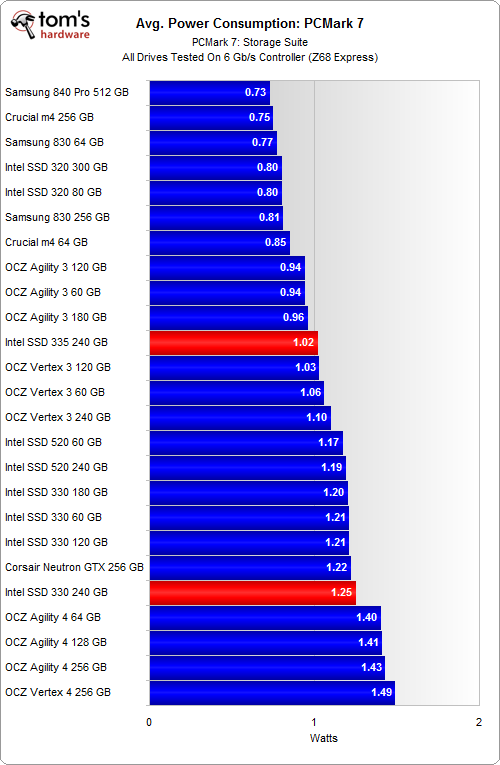Intel SSD 335 240 GB Review: Driving Down Prices With 20 nm NAND
Power Consumption: Idle And PCMark 7
Idle Power Consumption
Because SSDs are so fast, they sit idle most of the time. It's true! In almost our almost-30-minute virus scan, the SSD was only busy for 281 seconds. As a result, idle power consumption is the most important figure to consider in a desktop environment.
We've already seen Samsung's architecture fare particularly well in idle power measurements, despite its beefy triple-core ARM-based controller.
As far as the SSD 335 goes, besting the 240 GB Vertex 3 is a pretty big achievement, particularly when you look at how the SSD 330 and 520 did at the same capacity points.
PCMark 7 Power Consumption
With the exception of the Vertex 4, Agility 4, and Neutron GTX, the SandForce-based drives use more power than their competition when they're active.
Again, though, Intel cuts the SSD 335's power use compared to the SSD 330 and 520, keeping it at about 1 W during PCMark 7's Storage suite. At the 240 GB capacity point, Samsung's drivers are the only ones that do better.
Get Tom's Hardware's best news and in-depth reviews, straight to your inbox.
Current page: Power Consumption: Idle And PCMark 7
Prev Page Tom's Hardware Storage Bench And PCMark 7 Next Page 20 nm Write Endurance: Probably Not Something To Worry About-
mayankleoboy1 Read only the conclusion. Most of these SSD's are "me-too" clones using SF2281 controller. Most have similar performance wins and pitfalls.Reply
I was super excited about Samsung 840. But these are meh. -
christophermarti I would say that your estimates about P/E cycles are incorrect. You also do not mention (on purpose) two modes SSD's (99%) operate in: performance mode (not filled to 90%) and storage mode (filled 90% and more). You also lack to mention that in "middle of" P/E cycle exhaustion SSD's will slow down their speed due to preserve P/E cycles and "survive" to meet warranty agreements.Reply
http://www.xtremesystems.org/forums/showthread.php?271063-SSD-Write-Endurance-25nm-Vs-34nm/page211
From test exposed in this forum You can draw conclusion how good MLC used in X-25v 40GB SSD were (more than 35000 P/E). Also that longest "standing" SSD is Samsung 830 256GB, which also do not (as an exception) slow down considerably when it passes 1PB Host Writes mark.
Although I strongly do agree that seing writes above 10GB per day is rather rare. I'm myself using 80GB X25-M for 4 years and only 4,09 TB and i is possible that it will hold up to 1400 - 3400 TB of writes! That's amazing. What's more, I have it in Dell E6400 on Vista (no Trim, just Intel toolbox).
-
christophermarti http://www.xtremesystems.org/forums/showthread.php?271063-SSD-Write-Endurance-25nm-Vs-34nm&p=5148307&viewfull=1#post5148307 - 1000 P/E cycles (not even close to 35100 of 50nm old V40 GB).Reply -
alidan christophermartihttp://www.xtremesystems.org/forum ost5148307 - 1000 P/E cycles (not even close to 35100 of 50nm old V40 GB).Reply
keep in mind that is still 240000 gb of data at minimum -
abbadon_34 so if it's firmware crippled, can we just flash a the firmware and get a better drive? someone needs to do some testing....Reply -
acku christophermartiI would say that your estimates about P/E cycles are incorrect. You also do not mention (on purpose) two modes SSD's (99%) operate in: performance mode (not filled to 90%) and storage mode (filled 90% and more). You also lack to mention that in "middle of" P/E cycle exhaustion SSD's will slow down their speed due to preserve P/E cycles and "survive" to meet warranty agreements. http://www.xtremesystems.org/forum nm/page211From test exposed in this forum You can draw conclusion how good MLC used in X-25v 40GB SSD were (more than 35000 P/E). Also that longest "standing" SSD is Samsung 830 256GB, which also do not (as an exception) slow down considerably when it passes 1PB Host Writes mark.Although I strongly do agree that seing writes above 10GB per day is rather rare. I'm myself using 80GB X25-M for 4 years and only 4,09 TB and i is possible that it will hold up to 1400 - 3400 TB of writes! That's amazing. What's more, I have it in Dell E6400 on Vista (no Trim, just Intel toolbox).Reply
Our calculations and endurance protocol are not effected by any speed slow down, and in every test, we've confirmed our methodology applies a WA~1%. Thus, are estimates are correct and apply to the NAND itself.
Second, the speed of a drive has no inherent bearing on endurance. It only affects how fast you can get there. Second, you're referring to a throttling effect, which is a different topic completely. Our analysis was specific to the NAND itself.
As further verification, another one of my peers (at another site) independently came to results for the SSD 335 similar to ours. -
cumi2k4 how come vertex 4 did not get tested? didn't ocz offer 5 years for their vertex 4, and i believe they're offering them at cut-throat pricing?Reply -
mayankleoboy1 One thing i notice is that with an Antivirus program(Kaspersky Internet security) running in the background, which 95% of Toms readers would have, the AV program reads and writes data almost continuously. In a typical day, the AV program can write 5-6GB of data.Reply -
jabliese Power consumption made me laugh. 1 watt difference between the best and worst. Time for another 1 line standard SSD review comment, "Power usage on SSD's matters little between the best and worst."Reply
And please keep reiterating the most important thing about an SSD is getting one. Ran into SSD resistance on another forum just a couple weeks back, which, at today's price points, blew me away. -
acku cumi2k4how come vertex 4 did not get tested? didn't ocz offer 5 years for their vertex 4, and i believe they're offering them at cut-throat pricing?Reply
Look again. It is included in our benchmarks.

